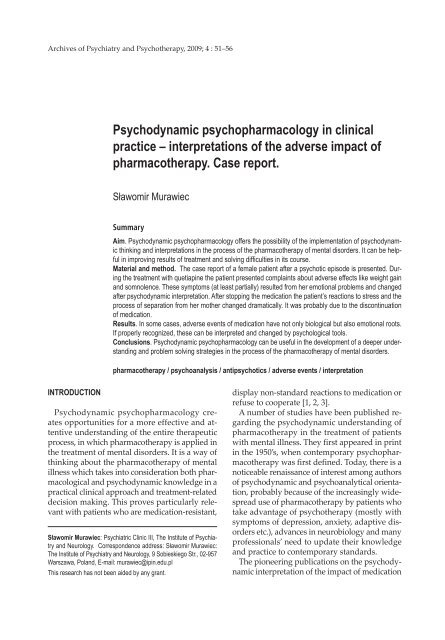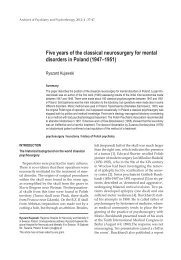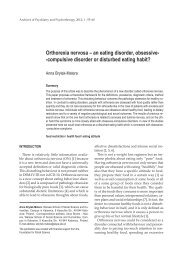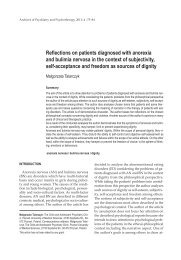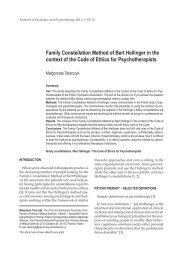Psychodynamic psychopharmacology in clinical practice ...
Psychodynamic psychopharmacology in clinical practice ...
Psychodynamic psychopharmacology in clinical practice ...
You also want an ePaper? Increase the reach of your titles
YUMPU automatically turns print PDFs into web optimized ePapers that Google loves.
Archives of Psychiatry and Psychotherapy, 2009; 4 : 51–56<br />
INTrOdUCTION<br />
Sławomir Murawiec: Psychiatric Cl<strong>in</strong>ic III, The Institute of Psychiatry<br />
and Neurology. Correspondence address: Sławomir Murawiec:<br />
The Institute of Psychiatry and Neurology, 9 Sobieskiego Str., 02-957<br />
Warszawa, Poland, E-mail: murawiec@ip<strong>in</strong>.edu.pl<br />
This research has not been aided by any grant.<br />
<strong>Psychodynamic</strong> <strong>psychopharmacology</strong> <strong>in</strong> cl<strong>in</strong>ical<br />
<strong>practice</strong> – <strong>in</strong>terpretations of the adverse impact of<br />
pharmacotherapy. Case report.<br />
Sławomir Murawiec<br />
Summary<br />
Aim. <strong>Psychodynamic</strong> <strong>psychopharmacology</strong> offers the possibility of the implementation of psychodynamic<br />
th<strong>in</strong>k<strong>in</strong>g and <strong>in</strong>terpretations <strong>in</strong> the process of the pharmacotherapy of mental disorders. It can be helpful<br />
<strong>in</strong> improv<strong>in</strong>g results of treatment and solv<strong>in</strong>g difficulties <strong>in</strong> its course.<br />
Material and method. The case report of a female patient after a psychotic episode is presented. Dur<strong>in</strong>g<br />
the treatment with quetiap<strong>in</strong>e the patient presented compla<strong>in</strong>ts about adverse effects like weight ga<strong>in</strong><br />
and somnolence. These symptoms (at least partially) resulted from her emotional problems and changed<br />
after psychodynamic <strong>in</strong>terpretation. After stopp<strong>in</strong>g the medication the patient’s reactions to stress and the<br />
process of separation from her mother changed dramatically. It was probably due to the discont<strong>in</strong>uation<br />
of medication.<br />
results. In some cases, adverse events of medication have not only biological but also emotional roots.<br />
If properly recognized, these can be <strong>in</strong>terpreted and changed by psychological tools.<br />
Conclusions. <strong>Psychodynamic</strong> <strong>psychopharmacology</strong> can be useful <strong>in</strong> the development of a deeper understand<strong>in</strong>g<br />
and problem solv<strong>in</strong>g strategies <strong>in</strong> the process of the pharmacotherapy of mental disorders.<br />
pharmacotherapy / psychoanalysis / antipsychotics / adverse events / <strong>in</strong>terpretation<br />
<strong>Psychodynamic</strong> <strong>psychopharmacology</strong> creates<br />
opportunities for a more effective and attentive<br />
understand<strong>in</strong>g of the entire therapeutic<br />
process, <strong>in</strong> which pharmacotherapy is applied <strong>in</strong><br />
the treatment of mental disorders. It is a way of<br />
th<strong>in</strong>k<strong>in</strong>g about the pharmacotherapy of mental<br />
illness which takes <strong>in</strong>to consideration both pharmacological<br />
and psychodynamic knowledge <strong>in</strong> a<br />
practical cl<strong>in</strong>ical approach and treatment-related<br />
decision mak<strong>in</strong>g. This proves particularly relevant<br />
with patients who are medication-resistant,<br />
display non-standard reactions to medication or<br />
refuse to cooperate [1, 2, 3].<br />
A number of studies have been published regard<strong>in</strong>g<br />
the psychodynamic understand<strong>in</strong>g of<br />
pharmacotherapy <strong>in</strong> the treatment of patients<br />
with mental illness. They first appeared <strong>in</strong> pr<strong>in</strong>t<br />
<strong>in</strong> the 1950’s, when contemporary psychopharmacotherapy<br />
was first def<strong>in</strong>ed. Today, there is a<br />
noticeable renaissance of <strong>in</strong>terest among authors<br />
of psychodynamic and psychoanalytical orientation,<br />
probably because of the <strong>in</strong>creas<strong>in</strong>gly widespread<br />
use of pharmacotherapy by patients who<br />
take advantage of psychotherapy (mostly with<br />
symptoms of depression, anxiety, adaptive disorders<br />
etc.), advances <strong>in</strong> neurobiology and many<br />
professionals’ need to update their knowledge<br />
and <strong>practice</strong> to contemporary standards.<br />
The pioneer<strong>in</strong>g publications on the psychodynamic<br />
<strong>in</strong>terpretation of the impact of medication
52 Sławomir Murawiec<br />
used <strong>in</strong> psychiatry appeared <strong>in</strong> the USA [4] and<br />
Canada [5, 6, 7, 8, 9]. They analysed the effect of<br />
the impact of medication from the po<strong>in</strong>t of view<br />
of psychoanalysis. These studies were cont<strong>in</strong>ued<br />
by such authors as Gutheil [10], Roose and<br />
Johannet [11], Nev<strong>in</strong>s [12], V. Kapsambelis [13],<br />
Gottlieb [14], Resnik [15] and Gabbard [16, 17,<br />
18]. Later on, however, <strong>in</strong> the 1970’s and 1980’s,<br />
such studies were only sporadically published.<br />
Today, the <strong>in</strong>creased <strong>in</strong>terest <strong>in</strong> the problems of<br />
the relation between psychoanalytical knowledge<br />
and pharmacotherapy is the focus of entire<br />
monographic issues of professional magaz<strong>in</strong>es,<br />
such as Revue Française de Psychanalyse, which<br />
are dedicated to the issue of pharmacotherapy<br />
<strong>in</strong> psychiatry (Les psychotropes sur le divan,<br />
2002;66) [19]. Other examples <strong>in</strong>clude articles <strong>in</strong><br />
the American Journal of Psychotherapy [20, 21,<br />
22], the 2006/3 issue of the Journal of the American<br />
Psychoanalytic Association [23], the 2007<br />
series of studies from the Austen Riggs Centre<br />
published <strong>in</strong> the Journal of American Academy<br />
of Psychoanalysis and Dynamic Psychiatry (<strong>in</strong>clud<strong>in</strong>g<br />
amongst others works by D. M<strong>in</strong>tz and<br />
B. Belnap on psychodynamic psychopharmacotherapy)<br />
[1, 2, 24, 25], or the studies published<br />
<strong>in</strong> the Bullet<strong>in</strong> of the Menn<strong>in</strong>ger Cl<strong>in</strong>ic [26, 27,<br />
28]. There is also Ostow [29], who published his<br />
first works <strong>in</strong> this subject area <strong>in</strong> the 1960’s and<br />
is still actively research<strong>in</strong>g and publish<strong>in</strong>g new<br />
articles. Altogether a few dozen substantial publications<br />
have appeared <strong>in</strong> recent years, but any<br />
detailed discussion of these is beyond the aim<br />
and subject matter of this article.<br />
The case study presented here illustrates an attempt<br />
to apply psychodynamic psychopharmacotherapy<br />
<strong>in</strong> cl<strong>in</strong>ical <strong>practice</strong>.<br />
CAsE sTUdy<br />
The subject is a 25 year old patient hospitalised<br />
<strong>in</strong> the psychiatric ward with a diagnosis of acute<br />
polymorphic psychotic disorder. Her medical<br />
record tells us that the cl<strong>in</strong>ical picture of her illness<br />
was dom<strong>in</strong>ated by a disorganization of psychic<br />
functions and an <strong>in</strong>creased labile affect. Prior<br />
to hospitalisation, the patient cried often and<br />
could not function effectively. She only spoke <strong>in</strong><br />
s<strong>in</strong>gle unrelated words or disconnected sentences,<br />
stopped go<strong>in</strong>g to work and either stayed <strong>in</strong><br />
bed or paced around her parents’ flat, <strong>in</strong> which<br />
she lived at the time. F<strong>in</strong>ally, due to an <strong>in</strong>tensified<br />
disorganisation of her speech and behaviour,<br />
difficulties with establish<strong>in</strong>g rational contact<br />
and a state of <strong>in</strong>creased agitation, she was<br />
hospitalized. She was medicated with quetiap<strong>in</strong>e<br />
and after a while also with citalopram, because<br />
of her lowered mood after the <strong>in</strong>itial few<br />
days. She was discharged <strong>in</strong> a much improved<br />
state and it was recommended that she cont<strong>in</strong>ue<br />
pharmacotherapy and beg<strong>in</strong> psychotherapy. The<br />
patient registered at the outpatient cl<strong>in</strong>ic, where<br />
she cont<strong>in</strong>ued to be medicated with the drugs<br />
<strong>in</strong>itially prescribed <strong>in</strong> the hospital.<br />
In therapy it was revealed that her hospitalization<br />
was preceded by a break-up with her<br />
partner of a few years. The relationship was described<br />
as a peculiar emotional bond, <strong>in</strong> which<br />
the patient was entirely subord<strong>in</strong>ated to her<br />
partner and was fused with him emotionally.<br />
She was always available to him, tried to meet<br />
all of his expectations, to have his thoughts and<br />
feel<strong>in</strong>gs. She was cont<strong>in</strong>ually preoccupied with<br />
experienc<strong>in</strong>g the relationship and th<strong>in</strong>k<strong>in</strong>g about<br />
it. In the <strong>in</strong>terview she also told the therapist<br />
that she had a similar symbiotic emotional relationship<br />
with her mother.<br />
situation I<br />
Dur<strong>in</strong>g the therapy session the patient compla<strong>in</strong>ed<br />
of weight ga<strong>in</strong>, which she thought was<br />
caused by tak<strong>in</strong>g quetiap<strong>in</strong>e. She said: “I’ve put<br />
on a lot of weight s<strong>in</strong>ce I’ve been tak<strong>in</strong>g quetiap<strong>in</strong>e.<br />
I’ve already put on 6 kg. I’ve been th<strong>in</strong>k<strong>in</strong>g<br />
of food all day and I get up at night to eat.<br />
All I can th<strong>in</strong>k of is food”. Weight ga<strong>in</strong> is one<br />
of the most frequently reported adverse effects<br />
of second generation antipsychotic medication<br />
and it may be a side effect of tak<strong>in</strong>g quetiap<strong>in</strong>e<br />
[30]; therefore the patient’s compla<strong>in</strong>ts could<br />
have been treated rout<strong>in</strong>ely as the side effect of<br />
the medication. However, <strong>in</strong> a longer conversation<br />
with the patient and after the analysis of<br />
what she had said to date, it was suggested to<br />
her that she consider two options: first that she<br />
ga<strong>in</strong>ed weight as a result of tak<strong>in</strong>g medication,<br />
and second that perhaps her <strong>in</strong>creased appetite<br />
and weight ga<strong>in</strong> happened for other reasons, especially<br />
feel<strong>in</strong>g emotionally empty.<br />
Archives of Psychiatry and Psychotherapy, 2009; 4 : 51–56
<strong>Psychodynamic</strong> <strong>psychopharmacology</strong> <strong>in</strong> cl<strong>in</strong>ical <strong>practice</strong> 53<br />
The patient said that when she was <strong>in</strong> the relationship<br />
with her former partner she did not<br />
feel like eat<strong>in</strong>g a lot but she felt that “her stomach<br />
was full and she had a lump <strong>in</strong> her throat”.<br />
She also said: “I beg<strong>in</strong> to eat a lot whenever I’m<br />
alone, and s<strong>in</strong>ce I’ve split up with my boyfriend<br />
and moved out of my mother’s house I have this<br />
suck<strong>in</strong>g sensation <strong>in</strong> my stomach all the time,<br />
and it feels empty. When I’m with someone, food<br />
might as well not exist. I don’t feel the hunger or<br />
the empt<strong>in</strong>ess – I am excited and animated then,<br />
I don’t have to eat. When I’m alone I miss this<br />
feel<strong>in</strong>g so I beg<strong>in</strong> to eat”.<br />
Eat<strong>in</strong>g and the relationship with her partner<br />
had a similar quality, which she described<br />
as follows: “Eat<strong>in</strong>g and my relationships with<br />
my boyfriend are both such that I feel bad afterwards,<br />
I feel aversion towards myself. Whenever<br />
I left my boyfriend’s house I felt dirty, I felt<br />
aversion towards myself. When I eat a lot I also<br />
feel aversion towards myself; that it looks like I<br />
stuffed myself aga<strong>in</strong>.”.<br />
The patient started talk<strong>in</strong>g about her feel<strong>in</strong>g<br />
that subjectively she felt as if someth<strong>in</strong>g important<br />
was miss<strong>in</strong>g from her <strong>in</strong>side. She said that<br />
she felt as if what was miss<strong>in</strong>g was: “… a filter<br />
of some sort, like I am filled with horrible dirt.<br />
When I lived with my mother at home, every<br />
day we talked from the early morn<strong>in</strong>g, and she<br />
talked th<strong>in</strong>gs through.. Now that I moved out I<br />
have no one to talk to and I feel this dirt <strong>in</strong>side<br />
me”. The follow<strong>in</strong>g week, the patient came for<br />
her visit early and said that she had to leave early<br />
as well. After the previous conversation with<br />
the therapist, she stopped eat<strong>in</strong>g as much dur<strong>in</strong>g<br />
the day and stopped gett<strong>in</strong>g up to eat at night.<br />
She began to take care of herself and jo<strong>in</strong>ed a<br />
physical activity class. Her activities had a def<strong>in</strong>ite<br />
mark of hyperactivity and she felt much<br />
more anger towards the people from her immediate<br />
circle. The patient saw a relation between<br />
various aspects of the change <strong>in</strong> her mood. She<br />
said: “I’m not stuff<strong>in</strong>g myself all the time so perhaps<br />
this is why I’m so angry”.<br />
The patient’s relationship with her mother also<br />
changed considerably dur<strong>in</strong>g this time. The patient<br />
started liv<strong>in</strong>g alone. Her mother, who <strong>in</strong>itially<br />
phoned her all the time and with whom the<br />
patient talked about everyth<strong>in</strong>g she did and described<br />
every person she met, stopped phon<strong>in</strong>g<br />
so much. The patient returned to work, <strong>in</strong> which<br />
Archives of Psychiatry and Psychotherapy, 2009; 4 : 51–56<br />
she was very much <strong>in</strong>volved, and tried to spend<br />
as much time as possible at work. Her relationships<br />
with her colleagues have improved, especially<br />
with men, because as she said: “Th<strong>in</strong>gs<br />
are different now because before I was cry<strong>in</strong>g<br />
all the time and didn’t talk to anyone so I had<br />
no contact with people. Now, when we can have<br />
a normal conversation, they are delighted and<br />
they take care of me <strong>in</strong> spite of my anger”.<br />
Dur<strong>in</strong>g the holidays the patient stayed at her<br />
parents’ house aga<strong>in</strong>. After this period she came<br />
for a visit and said that although she did not feel<br />
an <strong>in</strong>creased appetite, she “slept all the time after<br />
this medication”. She had never previously<br />
compla<strong>in</strong>ed of drows<strong>in</strong>ess. Dur<strong>in</strong>g the <strong>in</strong>terview,<br />
the patient was able to realize herself that she<br />
used the pretext of tak<strong>in</strong>g psychotropic medication<br />
to restrict contact with her family dur<strong>in</strong>g the<br />
holidays. In the period under discussion, the patient<br />
took steps to separate herself from her family;<br />
the holiday stay with her parents was difficult<br />
for her emotionally, so the “drows<strong>in</strong>ess” occurred,<br />
which she experienced subjectively. This<br />
drows<strong>in</strong>ess let her participate only <strong>in</strong> family celebrations,<br />
whereas otherwise she spent most of<br />
her time alone <strong>in</strong> her room.<br />
situation II<br />
The patient decided to stop tak<strong>in</strong>g quetiap<strong>in</strong>e<br />
entirely of her own account and after a few<br />
weeks came for a visit. She said that she went<br />
back to live with her mother because she started<br />
feel<strong>in</strong>g much worse once she stopped tak<strong>in</strong>g<br />
her medication. She felt <strong>in</strong>creased anxiety<br />
and feared the world around her. Although she<br />
was able to live alone before, and separate herself<br />
from her parents and limit her contacts with<br />
them, now she behaved altogether differently.<br />
She lived with her mother, with whom she spent<br />
most of her time after work. When she was at<br />
home she spent practically all her time with her<br />
mother; only then did she feel safe. She felt that<br />
someth<strong>in</strong>g bad could happen to her, so she demanded<br />
that her mother reassure her, tell her<br />
that everyth<strong>in</strong>g was go<strong>in</strong>g to be alright. Each<br />
time before leav<strong>in</strong>g home, she had spent a long<br />
time demand<strong>in</strong>g that her mother reassure her<br />
that noth<strong>in</strong>g wrong was go<strong>in</strong>g to happen to her<br />
and that everyth<strong>in</strong>g was go<strong>in</strong>g to be f<strong>in</strong>e. Her
54 Sławomir Murawiec<br />
mother put her to bed <strong>in</strong> the even<strong>in</strong>g and sometimes<br />
she slept with her. The patient noticed that<br />
the way she felt changed when she stopped tak<strong>in</strong>g<br />
quetiap<strong>in</strong>e and she thought that the calm<strong>in</strong>g<br />
effect that the medication had on her was<br />
now equivalent to the calm<strong>in</strong>g presence of her<br />
mother. She started call<strong>in</strong>g her mother, apparently<br />
jok<strong>in</strong>gly, with the name of the drug. Dur<strong>in</strong>g<br />
the visit she quoted the follow<strong>in</strong>g exchange<br />
with her mother as an example. The patient to<br />
her mother: “Quetiap<strong>in</strong>e, come here for a while”;<br />
Mother to the patient: “Quetiap<strong>in</strong>e is busy <strong>in</strong> the<br />
kitchen cook<strong>in</strong>g, can’t come now.”<br />
Once she stopped tak<strong>in</strong>g quetiap<strong>in</strong>e the patient<br />
had difficulties sleep<strong>in</strong>g. The pattern of her<br />
excessive eat<strong>in</strong>g also changed. Now the patient<br />
started hav<strong>in</strong>g attacks rem<strong>in</strong>iscent of bulimia:<br />
she ate a lot <strong>in</strong> a very short time, for example<br />
when she came back from work, but she did not<br />
vomit.<br />
dIsCUssION<br />
The medication used <strong>in</strong> pharmacotherapy can<br />
have the effect of chang<strong>in</strong>g the way one feels<br />
subjectively, one’s mood, ways of experienc<strong>in</strong>g<br />
th<strong>in</strong>gs and <strong>in</strong>terpret<strong>in</strong>g reality, ways of th<strong>in</strong>k<strong>in</strong>g<br />
of oneself and others, one’s fantasies and impressions;<br />
it can <strong>in</strong>fluence the psychic structure,<br />
aims and aspirations of the person who takes it<br />
but also the possibilities of their realization, the<br />
way that various tasks <strong>in</strong> life are undertaken and<br />
the development processes that take place. Ostow,<br />
who has been study<strong>in</strong>g pharmacotherapy<br />
analytically for over 40 years, th<strong>in</strong>ks that, e.g.,<br />
the impact of medication on the patient’s mood<br />
<strong>in</strong>fluences the overall way of experienc<strong>in</strong>g th<strong>in</strong>gs<br />
and <strong>in</strong>terpret<strong>in</strong>g life’s events, the way the patient<br />
perceives her- or himself, the type of fantasies<br />
she or he has and, through this extensive <strong>in</strong>fluence,<br />
the medication becomes the regulator of<br />
behaviour [29]. In this case study we can identify<br />
some important determ<strong>in</strong>ants of the impact<br />
of the medication with<strong>in</strong> the patient’s psychic<br />
structure and her attempts to undertake developmental<br />
changes (separation). When the drug<br />
is taken, the patient’s psychic structure is clearly<br />
consolidated; she beg<strong>in</strong>s to be more self-reliant<br />
and autonomous, and takes steps to get stronger<br />
<strong>in</strong>dependently from her parents and function <strong>in</strong>dependently,<br />
especially away from her mother.<br />
It is the particular aim of this study to consider<br />
the fact that the patient’s compla<strong>in</strong>ts, her<br />
accounts as regards to the medication’s impact<br />
(especially its adverse impact) may be <strong>in</strong>terpreted<br />
<strong>in</strong> various, not necessarily mutually exclusive,<br />
ways. Behavioural changes which could<br />
be perceived only <strong>in</strong> a biological context as the<br />
adverse effect of medication (<strong>in</strong>creased weight,<br />
drows<strong>in</strong>ess) are <strong>in</strong>terpreted psychologically<br />
and change under this <strong>in</strong>fluence. Other changes,<br />
which could be seen as “purely” psychological,<br />
such as the dynamics of the separation-<strong>in</strong>dividuation<br />
process and the dynamically chang<strong>in</strong>g<br />
relationship between the patient and her mother<br />
depend, perhaps, on the biological transformations<br />
caused by the pharmacotherapy-related<br />
changes <strong>in</strong> bra<strong>in</strong> functions.<br />
What is transparent <strong>in</strong> the case discussed here<br />
is the mutual replaceability of medication-relation-medication.<br />
Once the patient stopped tak<strong>in</strong>g<br />
quetiap<strong>in</strong>e, she turned emotionally to her<br />
mother. She herself was clearly aware of this situation<br />
and even gave it a name by jok<strong>in</strong>gly call<strong>in</strong>g<br />
her mother by the name as the drug. In the<br />
first situation described here, we can see that the<br />
‘objective’ adverse impact might have a clearly<br />
subjective dimension and may be <strong>in</strong>terpreted<br />
psychodynamically. Putt<strong>in</strong>g on weight is a frequent<br />
adverse reaction to second generation antipsychotic<br />
drugs, <strong>in</strong>clud<strong>in</strong>g quetiap<strong>in</strong>e [30]. It<br />
seems, however, that <strong>in</strong> the case of this particular<br />
patient putt<strong>in</strong>g on weight can probably be attributed<br />
to two simultaneously occurr<strong>in</strong>g sources,<br />
and could be partly modified by verbal <strong>in</strong>terpretation.<br />
Some of this impact resulted from the<br />
emotional situation of the patient (feel<strong>in</strong>g lonely,<br />
empty <strong>in</strong>side, emotionally “hungry”) and the<br />
<strong>in</strong>terpretation of this situation changed the <strong>in</strong>tensity<br />
of the related behaviour i.e. after the <strong>in</strong>terpretation,<br />
the excessive appetite and weight<br />
ga<strong>in</strong> were controlled for some time (<strong>in</strong> spite of<br />
her tak<strong>in</strong>g the same medication <strong>in</strong> the same dosage).<br />
The patient did, however, activate her psychological<br />
and behavioural mechanisms, <strong>in</strong>clud<strong>in</strong>g<br />
hyperactivity (manic defence) and a stronger<br />
perception of negative emotions.<br />
In the second situation described <strong>in</strong> this paper,<br />
we can consider an opposite direction of <strong>in</strong>terpretation<br />
i.e. the relationship of psycholog-<br />
Archives of Psychiatry and Psychotherapy, 2009; 4 : 51–56
<strong>Psychodynamic</strong> <strong>psychopharmacology</strong> <strong>in</strong> cl<strong>in</strong>ical <strong>practice</strong> 55<br />
ical behaviour to biological factors. S<strong>in</strong>ce the<br />
very beg<strong>in</strong>n<strong>in</strong>g of their usage, to beg<strong>in</strong> with <strong>in</strong><br />
surgery, neuroleptics were to cause, first of all,<br />
the effect of be<strong>in</strong>g unresponsive to stimuli [31].<br />
One of the first ever descriptions of the sensory<br />
isolation (effet d’isolement sensoriel) result<strong>in</strong>g<br />
from tak<strong>in</strong>g neuroleptics is attributed to the<br />
ground-break<strong>in</strong>g observations by Laborit, who<br />
used promethaz<strong>in</strong>e and chlorpromaz<strong>in</strong>e. He reported<br />
that his patients become semi-conscious<br />
and that the medication “may produce a veritable<br />
medic<strong>in</strong>al lobotomy”) [31]. What is essential<br />
is that contemporary neurobiological research,<br />
although its conceptualisation is different to the<br />
observations made by Laborit, Delay and Deniker,<br />
also notes the analogous impact of antipsychotic<br />
medication. The latest hypothesis is that<br />
the dopam<strong>in</strong>ergic mesolimbic system is <strong>in</strong>volved<br />
<strong>in</strong> physiological bra<strong>in</strong> activity and it mediates<br />
the detection of new, significant stimuli <strong>in</strong> the<br />
environment. In psychosis, the hyperactivity of<br />
this system is related to attribut<strong>in</strong>g more salient<br />
mean<strong>in</strong>gs to external stimuli and <strong>in</strong>ternal representations.<br />
Whereas the treatment with neuroleptics<br />
and second generation antipsychotics<br />
is l<strong>in</strong>ked with the effect of dampen<strong>in</strong>g the process<br />
of aberrant salience attribution through the<br />
antidopam<strong>in</strong>ergic impact. [32].<br />
If these facts were to be taken <strong>in</strong>to account as<br />
the basis of our reason<strong>in</strong>g, it could be assumed<br />
that after the patient stopped tak<strong>in</strong>g quetiap<strong>in</strong>e<br />
she subjectively, to put it <strong>in</strong> non-scientific<br />
language, “felt the reality surround<strong>in</strong>g her <strong>in</strong> a<br />
much stronger way”. Perhaps the sensitization<br />
process was also tak<strong>in</strong>g place for a while. The<br />
discont<strong>in</strong>uation of the use of the drug not only<br />
made the patient capable of attribut<strong>in</strong>g mean<strong>in</strong>gs<br />
and perceiv<strong>in</strong>g new stimuli <strong>in</strong> a “correct”,<br />
balanced way. It is also likely that the rebound<br />
attributions of mean<strong>in</strong>g were on the <strong>in</strong>crease.<br />
The patient started hav<strong>in</strong>g stronger responses to<br />
the stimuli from the surround<strong>in</strong>g environment,<br />
which caused her to feel threatened and <strong>in</strong> need<br />
of new sources of security. Her mother was the<br />
source of “feel<strong>in</strong>g safe” for her, so she went back<br />
to liv<strong>in</strong>g with her, and she cont<strong>in</strong>ually needed<br />
her mother’s presence. At that time, her mother<br />
was used by her to create an “anti-stimulus<br />
defence”. Understood <strong>in</strong> this way, the psychological<br />
and developmental processes which took<br />
place after the patient gave up the medication<br />
Archives of Psychiatry and Psychotherapy, 2009; 4 : 51–56<br />
were to a large degree conditioned by the withdrawal<br />
of quetiap<strong>in</strong>e from the treatment.<br />
Such <strong>in</strong>terpretations of the way the patient felt<br />
and behaved dur<strong>in</strong>g the treatment determ<strong>in</strong>ed<br />
the therapeutic decisions. In the first situation<br />
it was recommended that the quetiap<strong>in</strong>e treatment<br />
was ma<strong>in</strong>ta<strong>in</strong>ed. The alternative decision<br />
to change the medication to another drug could<br />
be the consequence of attribut<strong>in</strong>g the weight<br />
ga<strong>in</strong> and drows<strong>in</strong>ess to quetiap<strong>in</strong>e. Whether the<br />
decision was right or not is open to discussion.<br />
F<strong>in</strong>ally the patient stopped tak<strong>in</strong>g the medication,<br />
although she started compla<strong>in</strong><strong>in</strong>g of appetite<br />
dysfunctions and periodic drows<strong>in</strong>ess (the<br />
difficulty for the patient was that she could not<br />
attribute the drows<strong>in</strong>ess to the drug any more).<br />
In the second situation, the therapist discussed<br />
<strong>in</strong> detail the psychological processes tak<strong>in</strong>g place<br />
and their relation to the discont<strong>in</strong>uation of pharmacotherapy.<br />
At the time, the patient positively<br />
refused any further pharmacotherapy.<br />
CONClUsIONs<br />
The practical application of pharmacotherapy<br />
has many dimensions, such as the biological,<br />
psychological, social, cultural and economic.<br />
In many cases, tak<strong>in</strong>g psychodynamic factors<br />
<strong>in</strong>to consideration may contribute to a more effective<br />
way of us<strong>in</strong>g medication <strong>in</strong> the treatment<br />
of mental disorders. This type of psychodynamic<br />
psychopharmacotherapy may provide assistance<br />
<strong>in</strong> the choice of optimal strategies <strong>in</strong> various<br />
cl<strong>in</strong>ical situations. It may contribute to an<br />
adequate <strong>in</strong>terpretation of the processes which<br />
take place dur<strong>in</strong>g treatment and <strong>in</strong> the choice of<br />
psychotherapeutic or pharmacological <strong>in</strong>terventions,<br />
depend<strong>in</strong>g on the patient’s needs.<br />
rEFErENCEs<br />
1. M<strong>in</strong>tz D, Belnap B. A view from Riggs. Treatment resistance<br />
and patient authority –III. What is psychodynamic <strong>psychopharmacology</strong>?<br />
An approach to pharmacologic treatment resistance.<br />
J Am Acad Psychoanal Dyn Psychiatr 2006; 34:<br />
581- 600.<br />
2. Plakun EK. A view from Riggs. Treatment resistance and<br />
patient authority –III. “What is psychodynamic <strong>psychopharmacology</strong>?<br />
An approach to pharmacologic treatment resist-
56 Sławomir Murawiec<br />
ance”, by David M<strong>in</strong>tz and Barri Belnap. J Am Acad Psychoanal<br />
Dyn Psychiatr 2006; 34: 579-580.<br />
3. Murawiec S. Koncepcja psychodynamicznej psychofarmakologii<br />
D.M<strong>in</strong>tza i B.Belnap – omówienie w odniesieniu do<br />
pacjentów ujawniających oporność na leczenie. Psychiatr<br />
Pol 2008; 42: 323-333.<br />
4. Ostow M. Drugs <strong>in</strong> psychoanalysis and psychotherapy. New<br />
York: Basic Books; 1962.<br />
5. Sarwer-Foner GJ, Koranyi EK. Transference effects, the attitude<br />
of treat<strong>in</strong>g physician, and countertransference <strong>in</strong> the<br />
use of the neuroleptic drugs <strong>in</strong> psychiatry. In: Sarwer-Foner<br />
GJ eds. The dynamics of psychiatric drugs therapy. Spr<strong>in</strong>gfiled:<br />
Charles C Thomas Publisher; 1960. p. 402-417.<br />
6. Sarwer-Foner GJ. On the mechanisms of action of neuroleptic<br />
drugs: a theoretical psychodynamic exploration. The Hassan<br />
Azima Memorial Lecture. In: Wortis J. eds. Recent Advances<br />
<strong>in</strong> Biological Psychiatry, vol. VI. The proceed<strong>in</strong>gs of<br />
the eighteenth annual convention and scientific program<br />
of the Society of Biological Psychiatry, Atlantic City, N.J.<br />
7-9.06.1963. New York: Plenum Press; 1963. p.217-232.<br />
7. Sarwer-Foner GJ, Ogle W. Psychosis and enhanced anxiety<br />
produced by reserp<strong>in</strong>e and chlorpromaz<strong>in</strong>e. Can Med Assoc<br />
J, 1956; 74: 526-532.<br />
8. Sarwer-Foner GJ. The relationship between psychotherapy<br />
and pharmacotherapy: An <strong>in</strong>troduction. Am J Psychother<br />
1993; 47: 387-391.<br />
9. Azima H, Sarwer-Foner GJ. Psychoanalytic formulations of<br />
the effects of drugs <strong>in</strong> pharmacotherapy. Rev Canad Biol<br />
1961; 20: 603-615.<br />
10. Gutheil TG. The psychology of <strong>psychopharmacology</strong>. Bull<br />
Menn<strong>in</strong>ger Cl<strong>in</strong> 1982; 46: 321-330.<br />
11. Roose SP, Johannet CM. Medication and psychoanalysis.<br />
Treatments <strong>in</strong> conflict. Psychoanal Inq 1998;18: 606-620.<br />
12. Nev<strong>in</strong>s DB. Psychoanalytic perspectives on the use of medications<br />
for mental illness. Bull Menn<strong>in</strong>ger Cl<strong>in</strong> 1990; 54: 323-<br />
339.<br />
13. Kapsambelis V. Formulations psychanalytiques des effets<br />
neuroleptiques. Rev Franç Psychanal. 2002; 66: 447-464.<br />
14 Gottlieb R. A psychoanalytic hypothesis concern<strong>in</strong>g the therapeutic<br />
action of SSRI medications. J Am Psychoanal Assoc,<br />
2002; 50: 969-971<br />
15 Resnik S. Psychological and pharmacological medication <strong>in</strong><br />
psychoanalysis, with particular reference to psychosis. Arch<br />
Psychiatr Psychother, 2004; 6: 49-60.<br />
16. Gabbard GO, Kay J. The fate of <strong>in</strong>tegrated treatment: whatever<br />
happened to biopsychosocial psychiatrist? Am J Psychiatry<br />
2001; 158: 1956-1964.<br />
17. Gabbard GO. Basic pr<strong>in</strong>ciples and treatment approaches <strong>in</strong><br />
Dynamic Psychiatry. In: Gabbard GO. <strong>Psychodynamic</strong> Psychiatry<br />
<strong>in</strong> Cl<strong>in</strong>ical Practice. Second revised edition. Wash<strong>in</strong>gton:<br />
American Psychiatric Press. 2000. p. 3-170.<br />
18. Gabbard GO. Comb<strong>in</strong>ed psychotherapy and pharmacotherapy.<br />
In: Kaplan & Sadock’s Comprehensive Textbook of<br />
Psychiatry. Seventh Edition. Lipp<strong>in</strong>cott Williams and Wilk<strong>in</strong>s<br />
2000. p. 2225-2234.<br />
19. Revue Française de Psychanalyse. Les psychotropes sur le<br />
divan, 2002; 66.<br />
20. Hamilton NG, Sacks LH, Hamilton CA. Object relation theory<br />
and pharmacopsychotherapy of anxiety disorders. Am J<br />
Psychother 1994; 48: 380-388.<br />
21. M<strong>in</strong>tz D. Mean<strong>in</strong>g and medication <strong>in</strong> the care of treatmentresistant<br />
patients. Am J Psychother 2002; 56: 322- 337.<br />
22. Wilson SN. The mean<strong>in</strong>g of medicat<strong>in</strong>g. Pills and play. Am J<br />
Psychother 2005; 59:19-29.<br />
23. Journal of the American Psychoanalytic Association. Medication<br />
and Psychoanalysis. 2006; 54 (3).<br />
24. Plakun EM. A view from Riggs. Treatment resistance and patient<br />
authority I. A psychodynamic perspective on treatment<br />
resistance. J Am Acad Psychoanal Dyn Psychiatr 2006; 34:<br />
349- 366.<br />
25. Elmendorf D, Parish M. A view from Riggs. Treatment resistance<br />
and patient authority –V. Silenc<strong>in</strong>g the messenger: the<br />
social dynamics of treatment resistance. J Am Acad Psychoanal<br />
Dyn Psychiatr 2006; 34: 375-392.<br />
26. Swoisk<strong>in</strong> MH. Psychoanalysis and medication: is real <strong>in</strong>tegration<br />
possible? Bull Menn<strong>in</strong>ger Cl<strong>in</strong> 2001: 65: 143-159.<br />
27. Swoisk<strong>in</strong> MH. Further thoughts on dualism, science and the<br />
use of medication <strong>in</strong> psychoanalysis. Bull Menn<strong>in</strong>ger Cl<strong>in</strong><br />
2001: 65: 171-178.<br />
28. Cabaniss DL. Beyond dualism: psychoanalysis and medication<br />
<strong>in</strong> the 21st century. Bull Menn<strong>in</strong>ger Cl<strong>in</strong> 2001: 65: 160-<br />
170.<br />
29. Ostow M. Psychopharmacology and psychoanalysis. Isr Psychiatry<br />
Relat Sci, 2004:41: 17-22.<br />
30. Stahl SM. Podstawy psychofarmakologii. Leki przeciwpsychotyczne<br />
i normotymiczne. Gdańsk: ViaMedica; 2007.<br />
31. Cunn<strong>in</strong>gham-Owens A guide to the extrapiramidal side-effects<br />
of antipsychotic drugs. Cambridge: Cambridge University<br />
Press; 1999.<br />
32. Kapur S. Psychosis as a state of aberrant salience: a framework<br />
l<strong>in</strong>k<strong>in</strong>g biology, phenomenology, and pharmacology <strong>in</strong><br />
schizophrenia. Am J Psychiatry. 2003;160(1):13-23.<br />
Archives of Psychiatry and Psychotherapy, 2009; 4 : 51–56


